Inglis Surname Ancestry ResultsOur indexes 1000-1999 include entries for the spelling 'inglis'. In the period you have requested, we have the following 671 records (displaying 521 to 530): Single Surname Subscription | | | Buying all 671 results of this search individually would cost £3,700.00. But you can have free access to all 671 records for a year, to view, to save and print, for £100. Save £3,600.00. More... |
These sample scans are from the original record. You will get scans of the full pages or articles where the surname you searched for has been found. Your web browser may prevent the sample windows from opening; in this case please change your browser settings to allow pop-up windows from this site. Boys entering Uppingham School
(1900)
The public school at Uppingham in Rutland was founded by Archdeacon Johnson in 1584. A roll of scholars from 1824 to 1905 was edited by J. P. Graham, and published in 1906. This was a revision and updating of an 1894 edition of the roll, the great bulk of the work having been done by Mrs Mullins. The roll is arranged by year, and within each year by term of entrance, and then alphabetically by surname within each term. Each boy's name is given, surname first, with an asterisk where known (in 1906) to have died. Then there is month and year of birth, father's name (most often just surname and initials) and address (at entrance). Where the boy represented the school at Rugby football (XV) or cricket (XI), that is indicated. After the month and year of leaving the school, there is a brief summary of achievements in later life, and, where known, address as in 1906; but as late as this year, most boys were still at school and the entries are brief. From 1875 onwards the house within the school is also noted, with these abbreviations: A., Mr Constable's House; B., Brooklands; C., West Bank; E., Mr J. Gale Thring's House; F., Fircroft; Fgh., Farleigh; H., Highfield; L., The Lodge; L. H., Lorne House; M., Meadhurst; N., The Hall; R., Redgate; R. H., Red House; S., School House; and W. D., West Deyne.INGLIS. Cost: £4.00.  | Sample scan, click to enlarge
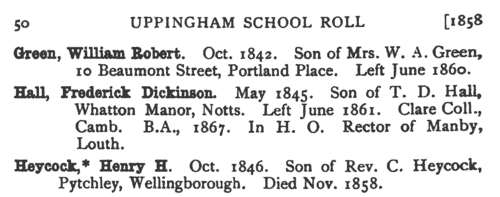
| Missing Next-of-Kin and Heirs-at-Law
(1900)
The Unclaimed Money Registry and Next-of-Kin Advertisement Office of F. H. Dougal & Co., on the Strand in London, published a comprehensive 'Index to Advertisements for Next of Kin, Heirs at Law, Legatees, &c., &c., who have been Advertised for to Claim Money and Property in Great Britain and all Parts of the World; also Annuitants, Shareholders, Intestates, Testators, Missing Friends, Creditors or their Representatives, Claimants, Unclaimed and Reclaimed Dividends and Stock, Citations, Administrations, Rewards for Certificates, Wills, Advertisements, &c., Claims, Unclaimed Balances, Packages, Addresses, Parish Clerks' Notices, Foreign Intestates, &c., &c.' The original list was compiled about 1880, but from materials dating back even into the 18th century: most of the references belong to 1850 to 1880. For each entry only a name is given, sometimes with a placename added in brackets: there may be a reference number, but there is no key by which the original advertisement may be traced. The enquirer of the time had to remit £1 for a 'Full and Authentic Copy of the Original Advertisement, together with name and date of newspaper in which the same appeared'. This appendix to the list was issued in about 1900.INGLIS. Cost: £4.00.  | Sample scan, click to enlarge

|  Outstanding soldiers of the East Surrey Regiment
(1881-1901) Outstanding soldiers of the East Surrey Regiment
(1881-1901)
Each year the best soldiers of the regiment were chosen for long service and good conduct medals. This register gives rank, name, regimental number, and date of recommendation. (The sample scan is from the East Surrey regiment). The register is essentially a register of recommendations, annotated with details of the issue of the medals. Where no gratuity accompanied the medal, the entry is marked 'W. G.' (without gratuity); where, for one reason or another, the medal was not issued, the entry is marked 'N. S.' (not sanctioned) and struck through. The regiment was based on the 31st Regimental District - Kingston-on-Thames. The 1st battalion, which had returned to England from Gibraltar in 1883 embarked for India (via Gibraltar) 22 December 1884, adding "Suakin, 1885" to the regimental honours, and in 1895 was stationed at Agra. The 2nd battalion embarked for Egypt 3 October 1884, taking part in the campaign of 1885; it returned to England later that year, was moved to Guernsey in 1888; to Ireland in 1891; to Malta in 1893; and to England in 1895. In 1899 it was sent out to South Africa, being present at Colenso, Spion Kop, Vaal Krantz, Pieter's Hill, the Relief of Ladysmith, and Alleman's Nek, and adding "South Africa, 1899-1902" and "Relief of Ladysmith" to the colours.INGLIS. Cost: £8.00.  | Sample scan, click to enlarge
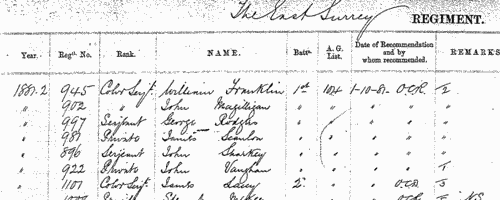
|  Outstanding soldiers of the King's Royal Rifles
(1881-1901) Outstanding soldiers of the King's Royal Rifles
(1881-1901)
Each year the best soldiers of the regiment were chosen for long service and good conduct medals. This register gives rank, name, regimental number, and date of recommendation. (The sample scan is from the East Surrey regiment). The register is essentially a register of recommendations, annotated with details of the issue of the medals. Where no gratuity accompanied the medal, the entry is marked 'W. G.' (without gratuity); where, for one reason or another, the medal was not issued, the entry is marked 'N. S.' (not sanctioned) and struck through. The rifle depot was at Gosport. The corps had four line battalions. The 1st battalion returned from Halifax, Nova Scotia, 2 January 1877, and was based at Limerick; it embarked for India 25 November 1890, and was stationed at Peshawar. The 2nd battalion returned from Bengal in 1882, and by 1885 was at Devonport; it embarked for Gibraltar 1 December 1891, and in 1895 was on Malta. The 3rd battalion embarked for Natal 19 February 1879, and in 1885 was on Cyprus; it returned from Gibraltar to England in December 1891, and in 1895 was at Shorncliffe. The 4th battalion embarked for India 2 November 1876, and in 1885 was at Ferozepore; it returned from India 4 December 1892, and in 1895 was at Dover. During the period of these records the corps fought in the Boer war (1881), the Egyptian war (1882) ("Egypt, 1882", "Tel-el-Kebir"), the Soudan campaign (1884: El Teb and Temai) ("Egypt, 1884"), the Hazara, Miranzai and Burmese expeditions (1890-1891), the Chitral relief force (1895) ("Chitral"), and the South African war (1899-1902: Talana, Rietfontein, Lombard's Kop, defence and relief of Ladysmith, Colenso, Spion Kop, Vaal Krantz, Pieter's Hill, Laing's Nek, Belfast and Lydenburg) ("South Africa, 1900-1902", "Defence of Ladysmith", "Relief of Ladysmith").INGLIS. Cost: £8.00.  | Sample scan, click to enlarge
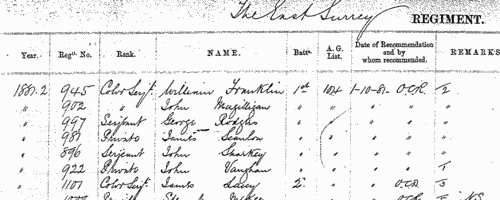
|  Outstanding soldiers of the Scots Guards
(1881-1901) Outstanding soldiers of the Scots Guards
(1881-1901)
Each year the best soldiers of the regiment were chosen for long service and good conduct medals. This register gives rank, name, regimental number, and date of recommendation. (The sample scan is from the East Surrey regiment). The register is essentially a register of recommendations, annotated with details of the issue of the medals. Where no gratuity accompanied the medal, the entry is marked 'W. G.' (without gratuity); where, for one reason or another, the medal was not issued, the entry is marked 'N. S.' (not sanctioned) and struck through. The 1st battalion returned from Egypt in 1882 and by 1885 was at Chelsea barracks; moving to Windsor by 1895. The 2nd battalion returned from Egypt 10 September 1885, the regiment having added "Egypt, 1882", "Tel-el-Kebir" and "Suakin, 1885" (in the Soudan) to the colours. In the South African war "South Africa, 1899-1902" and "Modder River" were added.INGLIS. Cost: £8.00.  | Sample scan, click to enlarge
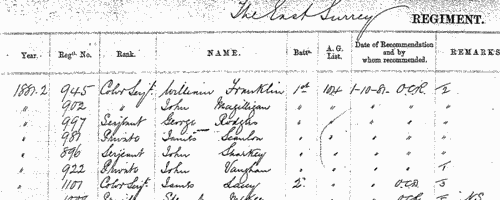
| Unclaimed Naval Prize Money
(1855-1902)
Various prize moneys were awarded to officers and men who served on board her Majesty's ships. For one reason or another a substantial number of these prizes, from as little as a shilling or two to as much as many pounds, remained undistributed by 1902, when this comprehensive list of the unclaimed moneys was printed: it lists unclaimed shares of prize money, slave and pirate bounties, salvage awards, parliamentary grants, gratuities and other moneys distributed by the Admiralty 1855 to 1902, but which omits moneys for service on the China Station during the war of 1856 to 1880, and special gratuities for service in Egypt (1882), Soudan (1884) and Soudan and Nile Expedition (1884-1885), for which there are separate indexes. In each case the sailor's name is given first (surname, then christian name or initials); rank or rating; ship in which serving at time of capture or award; and the amount due.INGLIS. Cost: £6.00.  | Sample scan, click to enlarge

|  British artillerymen fighting in South Africa
(1899-1902) British artillerymen fighting in South Africa
(1899-1902)
The Queen Victoria's South Africa Medal was awarded (after her death, in the event) to all who had served honourably in the various campaigns in the Boer War. Returns were made from each unit, and consolidated into nominal roll, of which this is the one for the Royal Artillery. Confusingly, the ledgers used had originally been printed for a register of men transferred (or re-transferred after mobilization) to 1st Class Army Reserve. All the original column headings were therefore struck through, and the roll was prepared with this information: Date of Issue; Regimental Number; Rank; Name; Unit; Medal (a 1 indicating that a medal was awarded); [number of] Clasps; the reference to the source in the original returns, usually starting with AG for papers in the hands of the Adjutant-General, and 68/Art/ for the Royal Artillery records. The final column, normally left blank, was occasionally used for explanatory remarks.INGLIS. Cost: £8.00.  | Sample scan, click to enlarge

| Eminent Lancashire Men of the Law
(1903)
The Contemporary Biography in 'Lancashire at the Opening of the Twentieth Century' was edited by William Thomas Pike. After opening with the most eminent men in the county, there are twelve sections, dealing with Nobility, Gentry and Magistrates; Clergy; Volunteers; Medical Men; the Legal Profession; Art, Music, Literary and Scholastic; Commercial; Dental; Architects, Engineers and Surveyors; Accountants, Auctioneers, Estate Agents, Insurance, &c.; Veterinary Surgeons; and an Obituary. Each biography usually (but not invariably) has a photograph; full name (surname first, in bold; christian name(s) in capitals) and address; birth place and date; father's name (and sometimes details); a short biography; whether married, with wife's name and her father's name and address.INGLIS. Cost: £4.00.  | Sample scan, click to enlarge
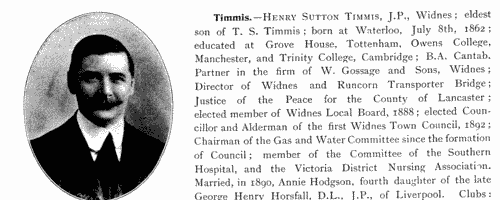
| Member of the North-East Coast Institution of Engineers and Shipbuilders
(1903)
This membership list, as of July 1903, is divided into four grades - Honorary Members, Members, Associates and Graduates. In each case the full name (or name and initials) is given with personal or business address, and month of election to that grade, and to the lower grades. The list is annotated with these abbreviations: A., Agent and Accountant; B. B., Boiler Builder; C. E., Civil and Consulting Engineer; E., Engineer and Boilermaker; E. A., Engineering Agent; E. E., Electrical Engineer; F., Iron and Brass Founder; F. M., Forge Master; I. & S. M., Iron and Steel Merchant or Manufacturer; M., Merchant; M. S., Marine Superintendent; N. A., Naval Architect; R. M., Rope Manufacturer; S., Shipbuilder; S. O., Ship Owner; SUR., Engineer & Ship Surveyor.INGLIS. Cost: £4.00.  | Sample scan, click to enlarge
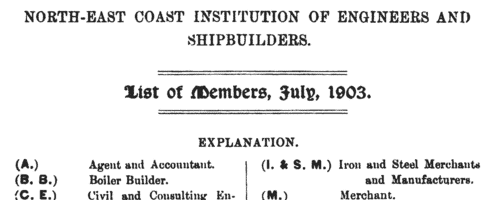
| Associate Members of the Institution of Civil Engineers
(1904)
The Institution of Civil Engineers was established 2 January 1818, and incorporated by royal charter 3 June 1828. The annual report lists the names and addresses (throughout the world) of the four classes of member - members (M. Inst. C. E.), associate members (Assoc. M. Inst. C. E.), associates (Assoc. Inst. C. E.), students (Stud. Inst. C. E.) - with the dates of admission. This is the index to the Associate Members. The symbols at the left of each page are * for Former Students, + for contributors of papers published in the Minutes of Proceedings, or of an Engineering Conference Note; F for a deliverer of a James Forrest Lecture; L for a deliverer of one of the Special Series of Lectures; and various letters for recipients of certain medals and prizes - B, Bayliss Prize; C, Crampton Prize; f, James Forrest Medal; H, Howard Quinquennial Prize; J, Joule Medal; M, Miller Scholarship; m, Miller Prize; italic m, Manby Premium; S, George Stephenson Medal or Prize; T, Telford Premium; t, Telford Premium; italic t, Trevithick Premium; and W, Watt Medal. Those elected prior to 2 December 1878 had been transferred into this class by the Council.INGLIS. Cost: £6.00.  | Sample scan, click to enlarge
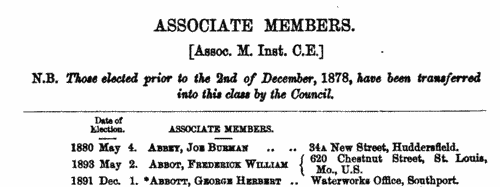
|
Research your ancestry, family history, genealogy and one-name study by direct access to original records and archives indexed by surname.
|













